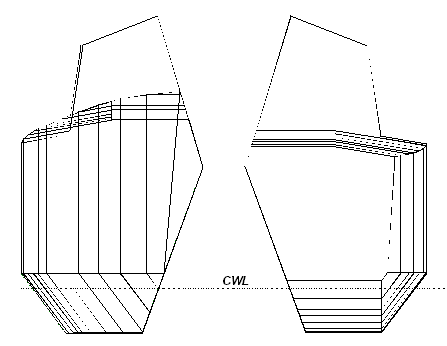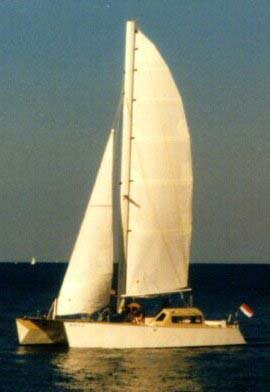|
Double Dutch
by Jacques Van Heijningen
What follows is a short description of my catamaran Double Dutch which I built in Switzerland during a 4 year period. Meanwhile I have moved to the USA and sail my cat on Lake Michigan.
Dimensions:
Length |
- |
33 ft. |
Beam |
- |
20 ft. |
Hull width |
- |
4 ft. |
Draft |
- |
1ft / 2 in. - 4ft / 7 in. |
Weight empty |
- |
5000 lbs |
Mast height above water |
- |
51 ft. |
Sail area |
- |
520 ft2 |
The hulls are made of 3/8 in. BRUINZEEL mahogany plywood “flo-coated” in and outside with WEST epoxy. The inside of the hulls is entirely flat and is slanted 15 degrees to the bottom. The outside is shaped as a circle. The outside is vertical above the waterline and is then slanted 35 degrees to the bottom. Towards the bow the draft is constant. This changes the under water shape from a trapezium to a triangle. Towards the stern the width of the bottom is constant thus reducing the draft towards the stern.

The shape is mathematically determined so that the center of buoancy, prismatic coefficient, etc. can easily be calculated. All 17 bulkheads are made of plywood. During the construction process the bulkheads were placed with the inside on two long timbers and positioned in the vertical position using wires diagonally tied to the timbers until the plywood skin was glued to the bulkheads. After completing the outside skin, bottom, and deck, the hull was turned in its vertical position and the inside skin was glued to the bulkheads.
Each hull has a daggerboard placed parallel to the inside skin. During sailing only the windward daggerboard is lowered. In the event of the windward hull leaving the water, the cat will slide over its leeward hull and prevents capsize. In order to point higher the daggerboards are placed 3 degrees to the centerline. Each hull has a small lexan window beneath the waterline. Unfortunately they are quickly covered with algae.
The hulls are connected with three round s.s. beams. The after beam and mast beam are 8.5 inch in diameter with a thickness of 1/8th. inch. The forward beam is 2.75 inch in diameter and has a seagull striker to prevent bending due to the high head stay tension.

The rotating mast rests on a dolphin striker to take the high compression forces. The after beam has a console on which both the main sheet wich and the jib sheet winch are positioned. The jib sheet is lead underneath the bridge deck. Between mast and afterbeam is a rigid bridge deck made from foam covered with glass fibre. The middle part contains three box sections for storage and seats. Left and right from this part are 4 ft. wide flat sections, also of glass covered foam. The freeboard of the bridge deck is 2 ft. which is sufficient because the parallel insides of the hulls prevent the build-up of waves.
Between mast and forward beam is a two part trampoline separated by a beam on the centerline. The original mast was made out of 3 sheets of veneer separated by layers of kevlar/carbon webbing. This mast snapped without warning when sailed in 35 kn. of wind with two reefs. Fortunately I was close to shore and the coast guard towed me back to the marina.
All halyards are lead through sheaves and clutches to a single winch on a table at the foot of the rotating mast. The shrouds are split into two parts which are attached to the mast beam and after beam. I use a wishbone which can be vertically moved on the front side of the mast and allows to change the tension in the foot of the main sail.

Each hull has two berths. The port hull contains a small sink, a two flame propane cooker and a little fridge. The starboard hull contains a foldable navigation table and a head, sink and waste tank. Head room in the cabin section is 6 ft. The inside of the cabin is slanted 20 degrees and contains a sliding door out of lexan. Between the two cabins I can rig a tent which goes over the wishbone when sailing with spi only or in the marina.
A daggerboard style rudder is hinged on each stern and an aluminum tube connects the two tillers. The rudders are 20% balanced which allows for finger tip steering. The long-shaft 9.5 HP outboard engine is attached to a cradle which rotates around the after beam. My expectations of the sailing performance are fully met. The cat sails 45 degrees to true wind with a speed of 15 kn.
|

